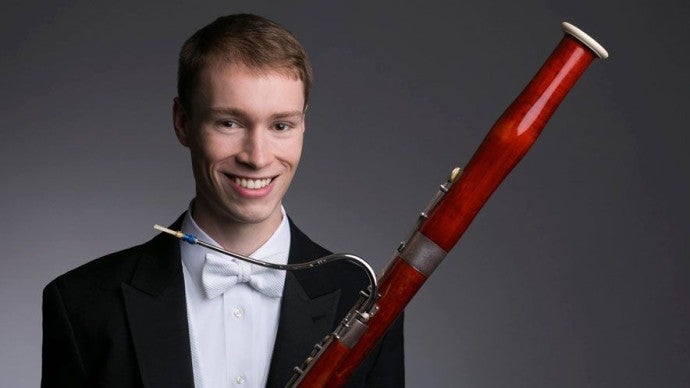Eight tips for preparing a piece
Keith Buncke, Chicago Symphony Orchestra principal bassoonist and Interlochen Arts Academy alumnus, shares his top tips for mastering a new piece.

Learning a new piece of music is daunting. It’s a multifaceted challenge that involves working out rhythms, finding the right notes, and teaching your fingers new shapes and patterns—all at once.
Professional musicians are presented with new music almost every day, and they’re expected to be able to play it proficiently within a short period of time. As such, they’re masters at learning new music and have dozens of successful strategies for preparing a piece from sight-read to stage.
We sat down with Chicago Symphony Orchestra principal bassoonist and Interlochen Arts Camp and Academy alumnus Keith Buncke (IAC 08, IAA 09-11) to learn his top tips for preparing a new piece:
1. Listen to recordings. One of the most useful things when you’re preparing a piece is listening to recordings. As you listen, pay attention to the tempos and get the basic idea of the piece into your head. Also pay close attention to how the players use dynamics, shaping, phrasing, and rubato. Really listen—don’t just hear—and be attentive to all the elements.
If you’re just starting to learn the piece, it’s okay to listen to just one recording. But as you get more familiar, vary it up a bit. Even if it’s a really good recording, you can potentially get into a bit of a mimicry if you’re always listening to the same performance.
2. Identify the most problematic spots and prioritize those spots. Don't just run through the piece again and again. Focus your attention on the difficult parts to make the most of your practice time. Work locally, then globally.
3. Use exercises/etudes related to problematic areas. For example, if you have a piece or concerto that is in F major, I would get really familiar with F major. Practice scales, thirds, and fourths. For bassoon, we have a really good etude and scale book called “Milde: 25 Studies in Scales and Chords” which has scales and etudes in each key. I would practice the etudes for the key that your piece is in.
For something that is more tone-based, like a slow movement, long-tone exercises can also be helpful. Focus on a single note or very slow scales to train your brain how to change from note to note. Using these types of exercises is like taking a different perspective or looking at the problem from a different angle—which is great advice that applies to other areas outside of music, too!
4. Identify problematic intervals. Every technical issue comes down to changing from one note to the next.
5. Slow tempo, but fast/precise fingers. One way of solving technical issues that I’ve found really useful is fingering on the instrument and without actually playing, focusing solely on the fingerings. Go through a passage—especially a fast or difficult passage—very slowly, but you move your fingers very quickly and aggressively. That sends a strong signal to your fingers and your brain that this is the exact motion that we need to go from this note to the next note. Focus on the tactile feeling, and see if you can get your fingers moving in good synchronicity. Often, you’ll find that it’s easier to faster since you’re used to going quickly anyway.
6. Don't practice mistakes. If you practice something wrong, it can be extra hard to unlearn those mistakes.
7. Record yourself/practice performing. Recording yourself can be a really helpful way to catch something you’re in the habit of doing that you haven’t noticed, like a glitch between your notes. When you listen to the recording, go back to the fundamentals. Does the pitch sound right? Do you move smoothly from one note to the next in terms of relative intonation and intervals sounding true? Is your tone beautiful from note to note? Is your rhythm steady? Also take note of your interpretation. Make sure that the rubato makes sense and serves the expressive needs of the music.
8. Know when to take a break and/or do some "mental practice." If you’re running into a wall, it’s probably a good time to take a break and come back later. Doing some mental practice is also a good way to get a fresh perspective. There are different ways to do this. You can do fingering exercises or other types of physical/mental exercises in that vein. I had one teacher who had me mime doing the fingerings for a piece—completely away from the bassoon—and sing the passage to increase the smoothness and legato of the line. It was a really interesting psychological trick.
I think it’s important to play the piece through in your head, which goes back to the initial phases where you’re just getting familiar with the piece by listening to recordings. Once you’ve played it yourself, your own way of executing it comes to fruition, and you can hear the piece in your head and visualize playing it even when you’re spending some time away from the instrument. Of course, sometimes taking a complete break and doing something else is good too.
Want more tips from professional musicians? Spend your summer studying with world-class artists at Interlochen Arts Camp.

